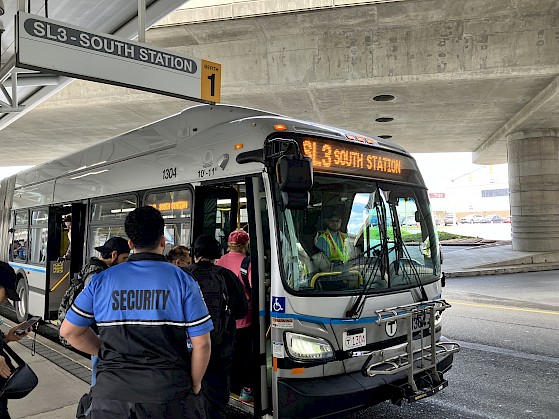Happening Now
Business Travel Conference: Why Not Rail?
June 13, 2025
By Jim Mathews / President & CEO
Major corporate travel bookers and the booking-systems companies that support them are beginning to embrace making passenger-rail and transit available in their portals to employees booking business travel as part of a larger strategy to “green” their business travel, but there are still a few obstacles to overcome.
Earlier this week I moderated a panel at the Global Business Travel Association’s Sustainability Summit, which focused on finding ways to make business travel more environmentally responsible. While that idea has fallen a bit out of favor in the U.S., in most other countries businesses face pressure from governments and corporate clients alike to reduce emissions and climate effects from business travel.
Attendees were enthusiastic, but the discussion surfaced a few reasons why it’s not as easy an answer for U.S. travelers as it might be elsewhere – and pointed the way to a few fixes that could make a big difference.
Routes and availability topped the list. For some business destinations, Amtrak is simply not a feasible choice. For others, Amtrak actually might be a good choice but the business, or the employee, doesn’t even know the service exists. The number of attendees I spoke to who didn’t realize Amtrak operated corridor services in 30 states was surprising.
An interesting number-two obstacle, however, is a driving force for business-travel agencies and corporate travel offices but not at all something I had thought about until meeting these providers this week – the responsibility of these providers for the safety of the traveling employee. It goes under the buzzword “duty of care,” language that’s lifted straight out of the common-law understanding of legal negligence.
Corporate travel managers rely more and more today on tech platforms like SAP Concur, Cytric, Traxo, or Egencia not just to book their tickets and itineraries, but to track their employees and even to deliver automated risk alerts based on flight disruption, civil unrest in a destination country, or disease outbreaks. Amtrak and commuter rail interfaces often lack tools to integrate with these platforms (known in the jargon as APIs, or Application Programming Interfaces), can’t offer reliable real-time tracking for individual passengers, and are sometimes not even available on global travel booking tools.
That means rail passengers can “go dark” when it comes to location visibility, and going dark leaves corporate travel managers uneasy as they consider their legal and ethical responsibilities to their traveling employees or clients under the Duty of Care standard. What makes it worse is Amtrak’s limited or inaccurate disruption alerts, varying security standards (things like baggage checks, ID verification, and so forth), and patchy communications during delays or service outages.
Speaking on the sidelines of the meeting, a few also admitted to me something they wouldn’t say out loud for the larger group: the perception of social stigma. It’s just not acceptable to allow a senior executive to travel on a train if that executive can fly instead. In many American corporate settings, there’s still an implicit hierarchy in which air travel is seen as professional, global, efficient, and predictable, while trains are local, public, less formal, riskier, and slower. When I told one of those people that my experience is that it’s common to see members of Congress and even two- and three-star generals in full military regalia riding the Blue line from the Pentagon into DC, they were shocked. (But it's true! Come see for yourself!)
Overall, in my remarks I identified three main obstacles to greater rail availability in the corporate-travel market.
First, air travel still dominates most of the booking platforms, most of which prioritize air travel, hotels, and rental cars by default. A corporate booker or employee booking through their employer’s portal often won’t see rail options as an available choice.
That leads me to my second obstacle, which is that Amtrak availability varies. Visibility and usability in tools like SAP Concur or Egencia depend on whether the company enables it with a programming rule. And even if the rule permits it, Amtrak could be deprioritized in search results or excluded from approved reimbursement categories.

Third, if you’re trying to incorporate local transit (such as I will often use on travel for the Association, jumping on the Blue line in Chicago, for example, or the Silver Line from Logan Airport into central Boston), buying those farecards just isn’t in the corporate equation. Employees are expected to use personal transit cards or pay out-of-pocket and submit receipts for transit fares – expenses that the automated travel systems often reject as impermissible. Meanwhile, Uber and Lyft are increasingly integrated directly into the platforms, further disadvantaging transit.
I advised the corporate travel departments attending our session to consider enabling Amtrak for approved routes in areas where their companies often have travel, to flag rail for more or higher priority, to include a transit-use case in their travel policy, to explicitly clarify in reimbursement policies that trains and transit are OK, and perhaps even offer pre-paid transit cards in high-use cities. Many urban transit agencies offer tax-advantaged employee-pass programs (although President Trump’s ‘Big Beautiful Bill’ spending plan would eliminate the tax advantage and force even nonprofits like ours to pay taxes on those benefits offered to employees).
"The COVID Pandemic has been and continues to be the biggest challenge faced by Americans as it has taken a deadly toll on the world and on the world’s economies. During COVID Locomotive Engineers at Amtrak and other Passenger and Freight Railroads have embodied the definition of essential workers. This dedication by our members is not new. We applaud the Rail Passenger’s Association for recognizing the vital contributions of our members and their hard work moving Americans and freight during the COVID pandemic."
Dennis Pierce, Brotherhood of Locomotive Engineers and Trainmen (BLET) National President
December 21, 2021, on the Association awarding its 2021 Golden Spike Award to the Frontline Amtrak Employees.
Comments